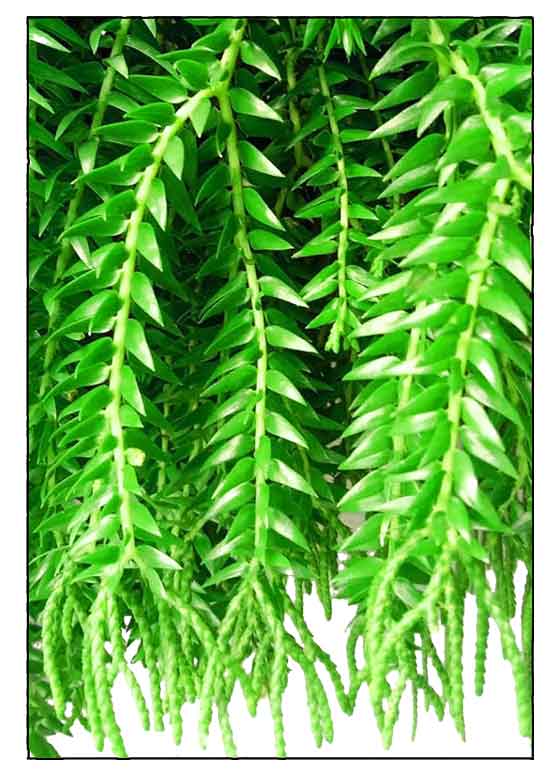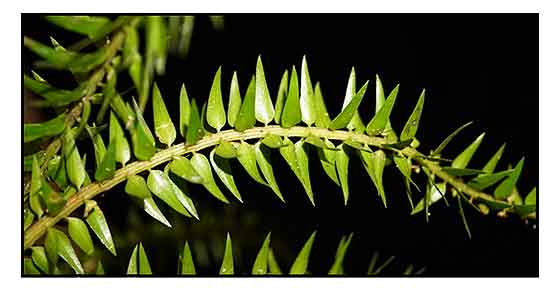 Gen info Gen info
- Huperzia is a genus of lycophyte plants, sometimes called firmosses or fir clubmosses. It is a genus mired in taxon conflicts.
The genus was originally included in the related genus Lycopodium. At present, Huperzia is one of three genera in the subfamily Hyperzioideae of the family Lycopodiaceae.
-
The PPG I classification had 25 species in the genus Huperzia. As of January 2023, World Ferns listed 61 species, with many species "still needing transfer into other split genera. (3)
Botany
Huperzia phlegmaria is an epiphytic, repeatedly forked, pendulous herb, up to about 2 m long. Stem pendulous, (15-)40-80(-190) cm × 1-2.5(-5) mm, 1-4 times branching into two equal branches at irregular intervals, brown, dark and lustrous in the oldest parts, paler near the growing point, coarse. Leaves subdistant, slightly twisted, spirally whorled in 4-8 rows, spreading, subpetiolate; lamina triangular to ovate-lanceolate, 4-15(-30) mm × 2.5-7 mm, base rounded-truncate or cordate, margins entire, yellowish-green, coriaceous, midrib prominent. Strobili terminal, cylindrical, (1.5-)4-15 cm × 1-2 mm, distinctly demarcated from vegetative parts of the stem, repeatedly dichotomously branched; sporophylls in four rows, crowded to subdistant, appressed, ovate-subdeltoid, about 1.2 mm × 1.5 mm, entire, green, turning yellowish at maturity, only partly covering the sporangium; sporangium borne at the base of the sporophyll, reniform, deeply grooved, sessile. Spores triangular, trilete, 35 μm in diameter, bright yellow, granulated. (2)
 Lycophytes, medium-sized. Stems caespitose, slender and pendulous, 4-6 times dichotomously branched, 20-40 cm, main stems ca. 3 mm in diam., stem together with leaves flat or nearly flat, not cordlike. Leaves conspicuously dimorphic. Trophophylls obliquely spreading, not lustrous, ovate-triangular, 5-10 × 3-5 mm, leathery, abaxially flat, midrib distinct, base cordate or subcordate, decurrent, conspicuously and shortly stipitate, margin entire, apex acuminate. Strobili terminal on branches, linear, 9-14 cm. Sporophylls sparsely arranged, ovate, ca. 1.2 × 1 mm, midrib distinct, margin entire, apex acute. Sporangia yellowish, reniform, vertically bisected. (Flora of China) Lycophytes, medium-sized. Stems caespitose, slender and pendulous, 4-6 times dichotomously branched, 20-40 cm, main stems ca. 3 mm in diam., stem together with leaves flat or nearly flat, not cordlike. Leaves conspicuously dimorphic. Trophophylls obliquely spreading, not lustrous, ovate-triangular, 5-10 × 3-5 mm, leathery, abaxially flat, midrib distinct, base cordate or subcordate, decurrent, conspicuously and shortly stipitate, margin entire, apex acuminate. Strobili terminal on branches, linear, 9-14 cm. Sporophylls sparsely arranged, ovate, ca. 1.2 × 1 mm, midrib distinct, margin entire, apex acute. Sporangia yellowish, reniform, vertically bisected. (Flora of China)
Distribution
- Native to the Philippines.
- Also native to Andaman Is., Assam, Bangladesh, Bismarck Archipelago, Borneo, Cambodia, Cameroon, China, Equatorial Guinea, Hainan, Himalaya, India, Japan, Laos, Liberia, Madagascar, Malawi, Malaya, Maluku, Nepal, New Guinea
, Queensland, Sri Lanka, Sulawesi, Sumatera, Taiwan, Thailand, Uganda, Vietnam, etc. (1)
- In moist forest and rainforests at high altitudes, among mosses and other epiphytes.
Constituents
- Study of aerial parts isolated two new abietane diterpenes, huperphlegmarin A-B (1-2), along with five known compounds including lycoxanthol (3), 21β-hydroxyserrat-14-en-3β-yl acetate (4), 21α-hydroxyserrat-14-en-3β-yl acetate (5), 21α-hydroxyserrat-14-en-3β-ol (6), and fawcettidine (7). (see study below) (4)
- Study of aerial parts isolated two novel Lycopodium
alkaloids, huperphegmine A and B (1 and 2), along with five known compounds lycophlegmariol A (3), phegmariurine B (4), 5-hydroxymethyl-2-furaldehyde (5), rhemanone C (6) and loliolide (7). (see study below) (8)
- Study of methanol extract of L. phlegmaria isolated pentacyclic triterpenoids, 21β-hydroxy-serrat-14-en-3α-ol (1) and 21β-hydroxy-serrat-14-en-3α-yl acetate (2) were isolated together with four serratene triterpeneoids established as 21β,29-dihydroxyserrat-14-en-3α-yl dihydrocaffeate (lycophlegmariol A, 5), 21β,24,29-trihydroxyserrat-14-en-3β-yl dihydrocaffeate (lycophlegmariol B, 6), 21α,24-dihydroxyserrat-14-en-3β-yl 4-hydroxycinnamate (lycophlegmariol C, 7), and 14β,21α,29-trihydroxyserratan-3β-yl dihydrocaffeate (lycophlegmariol D, 8) as well as a known lycophlegmarin (9), along with an abietane-type diterpene, 8,11,13-abietatriene-3β,12-dihydroxy-7-one (margocilin, 10), isolated for the first time. (see study below) (12)
Properties
- Studies have suggest cytotoxic and acetylcholinesterase inhibitory properties.
Parts used
Spores, aerial parts.
Uses
Edibility
- Young sporophyll and spores are dried, crushed into a fine powder, and used as herbal tea. (11)
Folkloric
- No reported folkloric medicinal use in the Philippines.
- In Tamil Nadu, India, whole plant is ground into a paste and applied over wounds to hasten healing.
(5)
- In India, young sporophyll and spores are crushed into a fine powder and made into herbal tea, used for the treatment of Alzheimer, Parkinson, and other neurological diseases.
(6)
- Used for washing hair to stimulate hair growth.
Others
- Rituals: Tribal people in India consider it a religious plant, kept in the pooja room, believing the plant can cure body sickness. (5)
Studies
• Acetylcholinesterase Inhibition / Huperphlegmarins A-B / Aerial Parts: Study of aerial parts isolated two new abietane diterpenes, huperphlegmarin A-B (1-2), along with five known compounds including lycoxanthol (3), 21β-hydroxyserrat-14-en-3β-yl acetate (4), 21α-hydroxyserrat-14-en-3β-yl acetate (5), 21α-hydroxyserrat-14-en-3β-ol (6), and fawcettidine (7). Compounds 3 showed inhibitory activity against AChE with IC50 of 465.6 µg/mL. (4)
• Acetylcholinesterase Inhibition / Potential for Alzheimer's Disease / Alkaloids / Aerial Parts: Huperzia phlegmaria has been used for enhancing memory and alleviating brain disorders. It is a potent acetylcholinesterase (AChE) inhibitor, which contains high amounts of alkaloids. Study of aerial parts isolated lycopodium alkaloids.. Ellman's assay isolated two compounds, fawcettidine and 12-epilycodoline N-oxide, which showed moderate AChE inhibitory effects with IC50s of 33.11 µg/mL and 64.56 µg/mL, respectively. The compounds could be promising drugs for treatment of Alzheimer's disease. (7)
• Acetylcholinesterase Inhibitory Activity / Lycopodium Alkaloids / Huperphlegmines A-B / Aerial Parts: Study of aerial parts isolated two novel Lycopodium
alkaloids, huperphegmine A and B (1 and 2), along with five known compounds. Compounds 1 and 2 showed moderate acetylcholinesterase inhibitory activities, with IC50s of 25.95 and 29.14 µg/mL, respectively. (see constituents above) (8)
• Effect on Cognitive Deficits Induced by Scopolamine: Study evaluated the in vitro AChE inhibitory activity of alkaloid extract (HpAE) and protective effects on mice with cognitive deficits induced by scopolamine. Results showed the HpAE had strong AChE inhibitory activity with IC50 of 5.12 µg/mL in a concentration dependent manner. Scopolamine induced cognitive impairment in Morris Water Maze and Y-Maze tests along with reduced levels of ACh and antioxidant enzyme and increased AChE activity in mouse brain tissues. Treatment with HpAE (30mg and 60 mg./kg) decreased SCP-induced cognitive impairment in both behavioral tests with decreased AChE activity and MDA level and increased ACh level and antioxidant enzyme in mouse brain tissue. Results suggest the HpAE at both doses has potential for prevention and treatment of Alzheimer's disease. (9)
• Phytocompounds with Acetylcholinesterase Inhibition Activity and Alzheimer's Disease / Review: Alzheimer's disease (D) is a neurodegenerative disease caused by formation of amyloid-beta (Aß) plaques and neurofibrillary tangles. AChE, a serine hydrolase, is the crucial enzyme in the hydrolysis of one of the most extensively known neurotransmitters acetylcholine (ACh) associated with the pathophysiology of AD. Study accumulates and reports on the data of medicinal plants with potential AChEi used for treatment of AD worldwide. (10)
• Lycophlegmariols A-D / Cytotoxic Serratene Triterpenoids against Lymphobastic Leukemia: Study of methanol extract of L. phlegmaria isolated pentacyclic triterpenoids, 21β-hydroxy-serrat-14-en-3α-ol (1) and 21β-hydroxy-serrat-14-en-3α-yl acetate (2) together with four serratene triterpeneoids, a well as a known lycophlegmarin, and an abietane-type diterpene. Lycophlegmariol B (6), D (8), and compound 1 showed inhibitory effects against MOLT-3 acute lymphoblastic leukemia (T-lymphoblast) with IC50 of 14.7, 3.0, and 2.9 µM, respectively. (see constituents above) (12)
Availability
Wild-crafted.
|

![]()



 Gen info
Gen info
